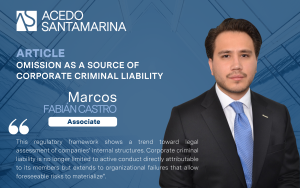In Mexico City, civil liability is regulated in the Civil Code for the Federal District in a chapter entitled ‘Obligations arising from unlawful acts’.
The performance of a wrongful act that causes damage generates subjective civil liability, in which case the victim will have the burden of proving the existence of fault or negligence on the part of the person who caused the damage. On the other hand, the strict liability action does not impose such burden of proof on the victim but the burden of proving that the tortfeasor used a dangerous object per se.
The subjective civil liability action requires the demonstration of: (i) an unlawful, culpable and harmful conduct, (ii) the existence of damage, and (iii) the causal link between the conduct and the damage.
On the other hand, the action of strict civil liability or liability for the risk created requires the victim to prove: (i) the use of dangerous mechanisms, instruments, apparatus or substances, (ii) the existence of damage, and (iii) the causal link between the act and the damage.
In this sense, strict civil liability is based on the use of a dangerous object per se, i.e., this type of liability may arise even if the tortfeasor has acted lawfully and without fault or negligence.
The damage caused is pecuniary or material if the victim suffers a detriment to his or her assets or is deprived of any gain that he or she should have obtained. On the other hand, moral damage implies the affectation of the victim’s immaterial goods and rights, such as honour, feelings, affections, beliefs, decorum, reputation or private life.
In ruling on amparos directos en revisión 1386/2020 and 5477/2024, the Supreme Court of Justice of the Nation established that article 1916 of the Civil Code for the Federal District (now Mexico City), which provides for the action to demand compensation for moral damages, as well as its different elements, depending on whether such damages are derived from subjective or objective civil liability, does not violate the principle of equality provided for in article 1 of the Political Constitution of the United Mexican States.
The substantial difference between subjective and strict civil liability is that in the former, the victim must prove the guilt of the person who caused the damage, an element that is not required in the case of strict liability, since the latter type of liability derives from the use of dangerous objects in themselves, that create a risk for the rest of the people, which makes the elements of fault or unlawfulness irrelevant.
However, as already stated, this difference does not imply a transgression of the principle of equality, since in both types of liability the victim will be obliged to prove the relationship between the damage and the cause, i.e. that the damage was caused by an unlawful act or omission (subjective civil liability) or that the damage derived from the use of a dangerous object (strict civil liability).
In any case, it is important to be clear about the elements that distinguish the two types of civil liability before bringing the corresponding claim before the courts.
At Acedo Santamarina, S.C., we are ready to advise and represent our clients in this and other matters through lawyers specialised in dispute resolution matters.
Roberto Altamirano





